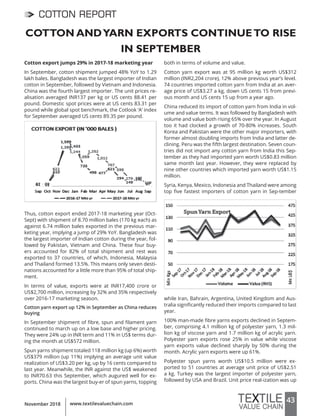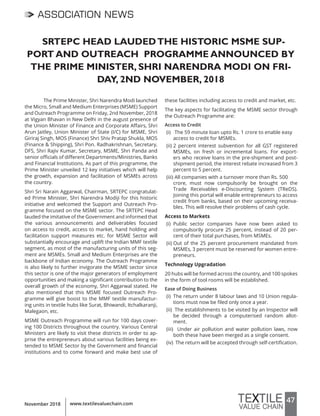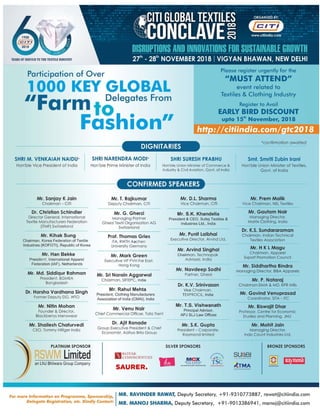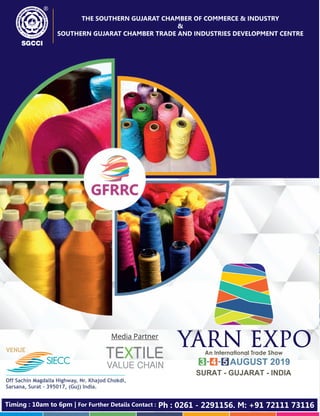The November 2018 issue of Textile Value Chain covers various topics, including an overview of the ITMA Asia + CITME 2018 event, advancements in textile machinery, and sustainable practices in denim production. It highlights innovative technologies like the isaverTM by Itema, which reduces waste in weaving, and Oerlikon's digital solutions for improving manufacturing efficiency. Additionally, the publication reports on the growth in cotton and yarn exports and features insights from industry leaders and experts in textile technology.


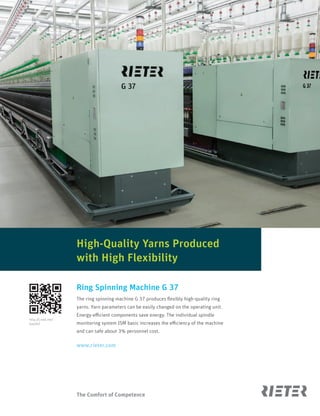


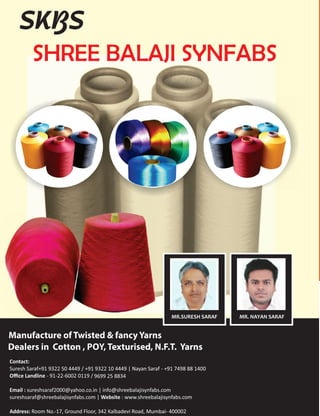

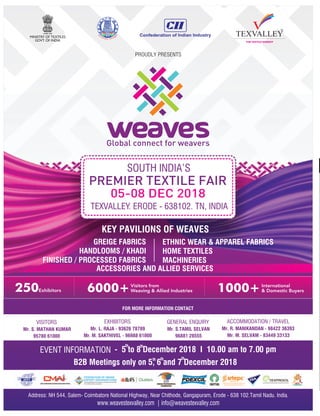
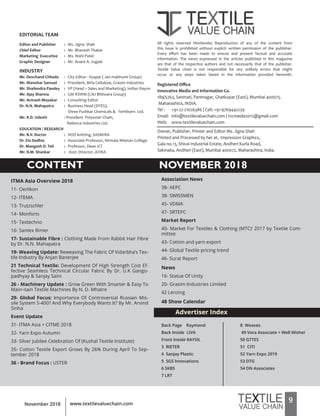
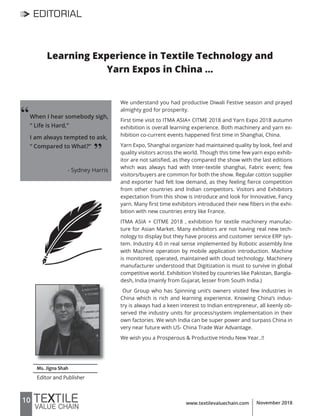







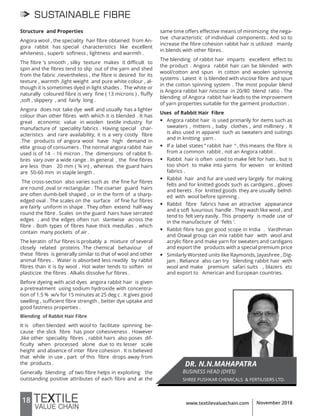

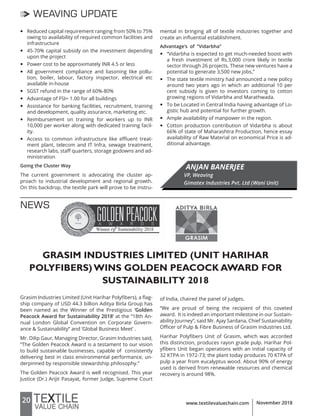
![21www.textilevaluechain.comNovember 2018
TECHNICAL TEXTILE
DEVELOPMENT OF HIGH STRENGTH COST
EFFECTIVE SEAMLESSTECHNICAL CIRCULAR FABRIC FROM HEAVY
DENIER MULTIFILAMENTYARNS
In modern times with emerging contribution of Technical
Textiles in all spheres of human life, the Geo-textiles have
opened up new areas in civil engineering. The technol-
ogy is gradually upgrading and regions which were earlier
unworkable are now being developed. However, in some
applications like Geo-textile Encased Columns for con-
struction of roads in extremely soft soils where tubular
structure of the fabric is formed by stitching; the seams
due to its lower strength and different fabric properties
have become a major concern for its implementation in
real structures as it adversely affects the structure. Due
to which there has been limited development in this field.
In this backdrop an affordable and locally available High
Strength technical seamless circular fabric from high ten-
sile strength synthetic yarns developed using simple cir-
cular weaving technology will be ideal for such and other
applications where circular Geo-textile is required espe-
cially for Indian sub-region.
Introduction
One of the sectors of textile industry that has received
significant attention across the world is Technical Textiles.
Technical Textiles are defined as textile materials and
products used primarily for their technical performance
and functional properties. Unlike conventional textiles
where aesthetic value is one of the key usage consid-
erations, Technical Textiles are used on account of their
specific physical and functional properties. Technical Tex-
tiles are used individually as a stand-alone product, or
as a component part of another product to improve the
performance of the product. Technical Textiles are also
referred to as industrial textiles, functional textiles, per-
formance textiles or engineering textiles.
Technical Textile has become a major segment globally
because of several advantages like functional require-
ment, health and safety, cost effectiveness, durability,
high strength etc. It is a large and growing sector and sup-
ports a vast array of other industries. The global growth
rates of technical textiles are about 4% per year greater
than the growth of home and apparel textiles, which are
growing at a rate of 1% per year.
Technical textiles are segregated into 12 major
segments
In recent times Geo-textile Encased Columns have be-
come most sought after technology the world over for
construction of civil structures on soft grounds. However,
for this structures tubular fabric is required [Figure1-Geo-
textile Encase Columns [GEC] for construction of roads
in soft soils].The advantages of tubular Geo-textiles,
drawback of present circular fabric structure, the new
seamless Circular fabric development and its benefits is
discussed here.
Figure1: Geo-textile Encased Columns [GEC]
Geo-textile Encase Columns
Large areas of India are covered with soft clay depos-
its, especially coastal regions. As a result of economic
growth, many infrastructure projects, such as roadway
embankments, are being constructed in areas with weak
soil deposits. Many challenging problems have been en-
countered with regard to construction on soft soil depos-
its including bearing capacity issues, excessive deforma-
tion, and slope instability. The instability or deep-seated
failure of a roadway embankment constructed on a soft
foundation has become a serious issue for geotechnical
engineers. Several ground improvement techniques have
been widely implemented to avoid deep-seated failures
in weak soils including sand compaction columns, stone
columns, and deep mixed columns. The problems due to
soft soils are low bearing capacity, excessive settlement
and deep seated foundation failure [Figure 2]
GEC
GEC
LOAD TEXTILE
Soft Soil
Hard Ground
Failure wedge
Embankment
Firm Soil](https://image.slidesharecdn.com/novemberissue2018finalpdf-181127060637/85/TEXTILE-VALUE-CHAIN-November-issue-2018-21-320.jpg)
![22 www.textilevaluechain.com November 2018
TECHNICAL TEXTILE
The stone column, or granular pile technique, has been
widely adopted to improve the soft soils through the in-
clusion of granular columns which have a stiffness and
drainage capability that is far higher than those of the
surrounding weak soil. In addition to the above benefits,
this technique is characterized by the ease of construc-
tion. Stone columns have been widely used since 1970s
to strengthen a foundation soil carrying heavy ironworks.
Since a stone column (see Figure 3a)) derives its bearing
capacity from the passive resistance offered by the na-
tive surrounding soil, the inclusion of stone columns in
very soft soils may not be sufficient to the desired level
of improvement. When embedded in soft clay, stone col-
umns may bulge due to lack of confinement offered by
the surrounding soft soil. Furthermore, the soft clay may
enter the voids between granular material of column to
cause clogging and reduce the permeability of granular
columns for drainage.
Therefore, Geo-textile encased stone columns (as shown
in Figure 3b) are proposed as a convenient technique for
improving soft soils that have un-drained shear strengths
lower than 15 kPa. Encasing the stone column within
Geo-textiles made up of woven high strength synthetic
yarns increases the stiffness of the column and thereby
increases its load capacity and no clogging of soft soil with
granular stone column when compared with the ordinary
stone columns.
Figure 3 (a) Ordinary stone column; (b) Geo-textile encased stone column
Figure 3: Illustration of advantages of Geo-textile encased columns
Figure 4.0: Installation of Geo-textile Encased Stone Columns [GEC]
The installation of Geo-textile encased stone columns
involves driving a steel casing with a closed end tip into
the ground to create a hole. A Geo-textile tube is then in-
serted inside the steel casing and the granular material is
then backfilled. The tip of the casing is opened as the steel
casing is withdrawn from the soil with vibration to densify
the infill material as shown in figure 4.0.
A. The Geo-textiles
Natural fibers such as flax, jute and ramie can be used
for most temporary application where, for instance, soil
erosion is the problem. The Geo-textiles made from these
natural polymers help to prevent the erosion of soils by
allowing vegetative growth and their subsequent root es-
tablishment. Once the purpose is served, the Geo-textile
material gradually disintegrates into the soil. In most me-
dium to long term applications as in Geo-textile Encased
Columns, Geo-tubes/bags where physical and chemical
durability and dimensional stabilities are of prime con-
cern, synthetic fibers are preferred. There are currently at
least four synthetic polymers considered suitable for this
purpose; they include: polypropylene, polyester, polyeth-
ylene and polyvinyl chloride.
Woven Geo-textiles form the major component of all
Geo-textile products. The manufacturing process involves
weaving of high tensile strength [≥ 6 GPD] and low elon-
gation yarns [<12-14%] into fabrics. Yarns of Polyester,
Polypropylene, and nylon in multi-filaments /monofila-
ment/tape forms are widely used in weaving. Multifila-
ment fabrics are characterized by their high strength and
resistance to stretch, these properties being enhanced as
the tenacity of the yarn increases. Multifilament yarns are
also more flexible than monofilaments, a property which
facilitates weaving of the tightest and most efficient of all
woven fabrics. Filament yarns of linear density 1100 dtex
and 2200 dtex are predominantly used in plain weave
constructions for Geo-textiles. Wide width looms are spe-
cifically used for producing Geo-textiles.
Woven Geo-textiles are mainly used for:
ƒ Reinforcement of Unpaved Roadways, Paved Road-
ways, etc
ƒ Separation applications in, Unpaved Roadways, Paved
Roadways, Sediment Control, etc.](https://image.slidesharecdn.com/novemberissue2018finalpdf-181127060637/85/TEXTILE-VALUE-CHAIN-November-issue-2018-22-320.jpg)
![23www.textilevaluechain.comNovember 2018
TECHNICAL TEXTILE
ƒ As components in geo-composites
ƒ Geo-textile Encased Columns [GEC] for Construction of
roads
ƒ Geo-tubes /Geo-bags for control of soil erosion in river
banks/coastal areas
B. Disadvantage of Present Tubular Geo-textiles
In majority of applications flat fabric suffices the require-
ment. However, in some special cases tubular structure
of the Geo-textile is required for example in GEC, Geo-
tubes, Geo-bags; which is formed by stitching fabric end
to end [Figure-5]. Seam is always a problem in a stitched
circular fabric as it introduces a weak point in the fabric
compared to other parts. The functional properties also
changes in the seam part of the fabric. During application
all parts of the fabric come under same stress and always
there are chances of failure at Seam. The Seam failure can
be highly dangerous to the structure.
Figure: 5 Tubular Geo-textiles with seam
The Loading tests performed on Geo-textile encased
sand columns in both air and surrounded with weak soil
showed that the Geo-textile sleeve typically failed at a
seam. This finding supports the practice of using seam-
less encasements in real structures [Figure 6].
Figure: 6 Failure of Tubular Geo-textiles at seam
C. Overcoming the shortcomings of present Tubular Geo-
textiles
In tubular Geo-textile the fabric is stitched end to end to
make a circular form, however the seam makes the fabric
weak and ineffectual for the purpose. In an attempt to
resolve the selvedge related issues in tubular Geo-textiles
SASMIRA, Mumbai have developed ‘High Strength Cost
effective Seamless Technical Circular Fabric from Heavy
Denier Polyester Multifilament Yarns’ which will give sig-
nificant advantage. It can be used for Geo-textile Encased
Columns in construction of roads in soft soils [Figure 1]
and also in Geo-bags& Geo-tubes for control of soil ero-
sion in river banks/coastal areas where stitched fabric
is used [Figure 7]. SASMIRA has filed patent for this de-
velopment [Application No.E-2/2502/2017-MUM Dated
15/11/2017]. At present there is no manufacturer for this
kind of Geo-textiles in India
Figure: 7 Geo-tube Geo-bags
D.Development of High Strength Seamless Fabric with
Polyester Multi-filament Yarns
It is pertinent to mention that Tubular Geo-textile was at-
tempted on conventional shuttle loom on double cloth
principle. However, due to coarse and low twist synthetic
Multifilament Yarns, there was thread distortion and fila-
ment rupture leading to reduction in desired properties
in selvedge region due to use of strong temples as com-
pared to body [Figure-8].
Figure: 8 weaving fault of Tubular Fabric at selvedge
Therefore, to avoid the selvedge related problems in the
fabric circular weaving principle was adopted. Circular
Loom is a weaving machine in which two or more shuttles
move simultaneously in a circle, laying weft threads in a
section of warp thread, forming a shed. They are used in
the production of hoses and bags. The warps rise and fall
with each shuttle passage, unlike the common practice
of lifting all of them at once [Figure.9]. Here the bobbins
are mounted on the creel which serves as warp and weft
is inserted by rotating shuttles in the multiple plain shed
formed by the Heddle belts connected to cams. The circu-](https://image.slidesharecdn.com/novemberissue2018finalpdf-181127060637/85/TEXTILE-VALUE-CHAIN-November-issue-2018-23-320.jpg)
![24 www.textilevaluechain.com November 2018
TECHNICAL TEXTILE
lar fabric is then pulled by take up roller and finally wound
on winder.
Figure: 9 Circular Weaving Machine
Advantages of Circular loom
y Circular Weaving Principal - Simple technology
y Multiple pick insertion – High Productivity
y No Selvedges - Not possible on modern shuttle-less
looms
y Economical as many steps of conventional weaving
are not required like re-winding, warping, frequent
gaiting etc.
The specifications of the fabric for use in Geo-textile En-
cased Columns [GEC] were decided like yarn Tenacity,
count, EPI, PPI and TPM of warp and weft. After several
trials the Proposed Seamless fabric was developed on the
Circular Loom after modifications/precautions as under:
ƒ Controlled warp let-off
ƒ Smooth warp passage
ƒ Application of anti-static oil
ƒ Optimum twist application
ƒ No cuts/worn out tensioners and heddles
ƒ Suitable Take up roller cloth for heavy fabric
ƒ Correct rating of take up & batch roller motor to take
the load
ƒ Compact wound weft bobbin
ƒ Clear Shed Formation
ƒ Ceramic guides at important points
ƒ Frequent cleaning of machines with compressed air
ƒ Strong spreader arrangement
Figure:10 Polyester MFY High Strength Seamless Fabric on Circular
Weaving Machine
The test results of 400mm diameter Seamless Circular
fabric developed with high tenacity Polyester Multi-fila-
ment Yarns [MFY] for Geo-textile Encased Columns [GEC]
are as under:
From above it can be inferred that the developed sample
meets the necessary specifications.
Benefits of developed Seamless Tubular Geo-textile for
stone columns:
y The seamless circular structure with Multi-Filament
Yarns capable of being developed on existing circular
weaving looms with locally fabricated modifications
y Reinforcement sleeve diameters between 0.4 m and
1.0 m can be made
y The developed fabric is technically in compliance with
recommended parameters
y The indigenous Circular looms are costing from Rs. 15-
45 lacs as per diameter. Whereas, imported shuttle
weaving machines capable of making tubular struc-
ture on double cloth principle costing about Rs. 3-4
Crores. The conventional technology will further add
to final cost due to higher conversion charges.
y High Denier yarn can be woven easily [ up-to 20000 dn
& more ]
y High GSM fabric can be developed [ ≥ 1000 GSM ]
y High Tensile strength fabric possible [≥400 kN/m]
y Affordable Cost of circular fabric for Indian mark
y Suitable for soft soils with cu < 15 kN/m²
y Almost all settlement takes place within construction
period
y Adjacent buildings are unaffected by settlement
y System is fully loadable immediately after completion
y High embankments can be built in short time with no
Sr.
No.
Parameter Test Standard Unit Values
Recommended
Achieved
Value
1. Weight/Sq mts ASTM D
5261-10
GSM -- 972
2. Tensile
Strength [MD]
ENISO 10319 Kn/m 100-110 112.0
3. Elongation at
maximum load
[MD]
ENISO 10319 % 7- 13 14
4. Tensile
Strength [CD]
ENISO 10319 Kn/m 300 - 330 375.9
5. Elongation at
maximum load
[CD]
ENISO 10319 % 7 - 13 16
6. Water
Permeability
ASTM
D4491-16
Lt/sq
mt/sec
10-20 13.5
7. Static Puncture
test
ENISO
12236-06
kN 7-12 14.7
8. Dynamic
Perforation
ENISO
13433
mm 15-20 No Hole
Formation](https://image.slidesharecdn.com/novemberissue2018finalpdf-181127060637/85/TEXTILE-VALUE-CHAIN-November-issue-2018-24-320.jpg)
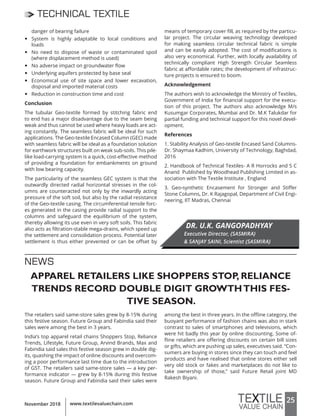
![26 www.textilevaluechain.com November 2018
MACHINERY UPDATE
Textile industry is resource intensive and is often criti-
cized for its environmental performance. Textile process-
es rely heavily on water, energy, and synthetic dyes and
chemicals. Where it is noted that this Industry is consum-
ing 1 trillion gallons of water, 33 trillion gallons of oil, and
20 billion pounds of chemicals -(Cotton Incorporated).
Where the Machines play a vital role in controlling the
consumption of the above natural resources as well as
controlling the pollution of air, water, environment &
ecological aspects; and also conservation of energy, lubri-
cants, dyes, chemicals, etc.
Manufacturing technology is not what it used to be a dec-
ade ago. Today’s increasingly automated and software
driven industries have reduced human intervention to
pressing only a few buttons in some cases. The applica-
tion of advanced technologies in manufacturing such as
nanotechnology, cloud computing, the Internet of Things
(IoT) is changing the face of manufacturing in ways un-
imaginable a few decades ago. In addition to cutting the
costs, these technologies create speed, precision, effi-
ciency and flexibility for manufacturing companies.
It’s no secret that OEMs are looking to build more “intel-
ligence” into mobile and industrial machines. The goal
is to make the equipment they sell more productive and
efficient, safer, and easier to operate and maintain. Fur-
ther marrying electronic controls and software with hy-
draulics, pneumatics and mechanical systems equating
to lower fuel consumption, lower emissions, faster cycle
times, safer operation, easy-to-access data metrics and
condition.
Equally important, the basis of competition is shifting to-
ward delivering excellence in service and parts manage-
ment. The digital revolution is now breaching the walls of
manufacturing as it continues to disrupt media, finance,
consumer products, healthcare, and other sectors.
Indeed, the explosion in data and new computing capa-
bilities along with advances in other areas such as artifi-
cial intelligence, automation and robotics, additive tech-
nology, and human-machine interaction—are unleashing
innovations that will change the nature of manufacturing
itself.
Industry and academic leaders agree that digital manu-
facturing technologies will transform every link in the
manufacturing value chain from research and develop-
ment, supply chain, and factory operations to marketing,
sales, and serice.
Digital connectivity among designers, managers, work-
ers, consumers, and physical industrial assets will unlock
enormous value and change the manufacturing land-
scape forever.
Consider traditional car manufacturers and Uber, which
are both at the highest level in the business of moving
people around.
Car makers meet that need on the floors of factories and
showrooms, using a century of manufacturing experi-
ence.
Uber meets people’s transportation needs not with steel,
glass, rubber, and sales people but with data, matching
individual riders and vehicles via smart phones. Barely
five years into its existence, it is valued at about $50 bil-
lion.
Uber’s data, algorithms, and enormous growth pros-
pects have already made it more valuable than all of the
physical assets, intellectual property, and brand names of
some of the world’s biggest car manufacturers.
Further with the application of 3D printing technology it
is now possible to produce almost any component using
metal, plastic, mixed materials and even human tissue.
Presently Indian production of textile machines is 1.2 bil-
lion USD against 2.7 billion USD market size India Exports
0.5 billion USD and Imports 2.1 billion USD.
This Industry has a huge supply chain of Ginning, Spinning,
Weaving & its Preparatory, Wet Processing, Garment, Ap-
parel and Fashion. As the field of the subject is very vast
the content of this article is restricted to the Technological
Development in the design aspects of Weaving & Weaving
Preparatory machines and their Lubrication systems to
grow green. Lubricants and Lubrication plays a very vital
role in this Industry considering variety of machines are
working with different speeds, loads, under different en-
vironments of humidity, temperature, chemicals, fumes,
steam, fluff, etc. and accordingly a remarkable develop-
ment have been taken place in the grades and properties
of lubricants as well as its application system.
Weaving Loom Shed
While noise pollution is the main concern in a Weaving
shed, while the discharge of water with chemicals in siz-
ing is a headache in the weaving preparatory sector. In
the looms, shuttle picking motions which is supposed to
be the heart of the loom and so the noise producing mo-
tion has been replaced by various lighter medium tech-
nologies like projectile, rapier, water and air-jets. [Fig-1
& 1(a)]. Shuttle of about half kg. weight was considered
to be the heaviest carrier of the weft, consuming highest
energy and maximum travel time. It is now replaced with
GROW GREEN WITH SMARTER & EASYTO
MAINTAIN TEXTILE MACHINES](https://image.slidesharecdn.com/novemberissue2018finalpdf-181127060637/85/TEXTILE-VALUE-CHAIN-November-issue-2018-26-320.jpg)
![27www.textilevaluechain.comNovember 2018
MACHINERY UPDATE
lighter or no weight and faster mediums.
1&1(a) Shuttle, Projectile, Rapier, Water and Air-jet heads
Further the replacement of plastic/leather material used
as a shock absorbent by a Zama Buffer and Hydraulic
Dampers [(Fig-2 & 2(a)] and also introduction of Special
Weltac Oil have considerably reduced noise due to bang-
ing of picking stick and picking nose with picking bowl,
further enhancing the life of these spares.
2 & 2 (a) Zama Buffer and Hydraulic Dampers
The crank beat up motion, being additionally noise pro-
ducing, is now converted to cam motions. [Fig-3 & 3 (a)].
The basic principle of Common Drive is shifted to Individ-
ual drive and at the same time introduction of compact
and effective trapezoid belts replacing the conventional
flat, v-belts, resulted in reduction of speed losses due to
slippages, and lead to effective loom stoppage.
3 &3 (a) Crank Beat- up motion and Cam motion.
The functioning of Secondary Motions like Take-up and
Let-off through mechanical linkages controlled by one
point Tappet motion is now separately controlled through
Servo motors thus executing the action very fast and fur-
ther saving lubricants and electrical power, further pre-
serving noise at the lowest level.
The lengthy linkage of Cam, roller and levers working on
frictional principle as a driving motion in the Shedding As-
sembly is replaced by a direct drive through a one piece
cam of steel in oil bath [Fig-4 & 4(a)] and levers having a
positive drive to the heald frames, by providing all these
assemblies outside the loom at one side thus resulting to
be User Friendly to the operative and also reducing wear
and tear, downtime for lubrication and manual interven-
tion.
4 & 4(a) Conventional Shedding Assembly and One piece Cam of Steel
in Oil bath
Further, open oil holes are converted to oil baths/oil res-
ervoirs [Fig-5 & 5 (a)] and self lubricated bearings, which
apart from reducing the consumption and contamination
of lubricants also helps in reducing the heat generated
due to friction created among the high speed spares, thus
further reduces the machine downtime and human inter-
vention.
5 & 5 (a) Conventional loom with Open Oil holes and Developed
Looms with Oil baths/Oil Reservoirs
The introduction of Super speed Shuttleless looms have
demanded an effective lubricants and their application
systems as in Projectile Shuttleless loom where high vis-
cosity oil does not centrifuges away but remain on fast
moving chain and avoids transfer of heat generated by
chain on to projectile; while in Rapier looms force circula-
tion lubrication system is effective at all assemblies; and
in Air-jet looms the Oil Circulating system with filters help
in sustaining the status of lubricants inherently.](https://image.slidesharecdn.com/novemberissue2018finalpdf-181127060637/85/TEXTILE-VALUE-CHAIN-November-issue-2018-27-320.jpg)
![28 www.textilevaluechain.com November 2018
MACHINERY UPDATE
Weaving Preparatory Section
The developments in attending the broken thread manu-
ally on conventional common drive winding machine to
individual spindle driven with a knotting and splicing sys-
tems have remarkably increased the productivity, prod-
uct quality, wear and tear of spares due to idle spindle
running, lubricants and proved to be User-friendly. The
incidences of costly Bakelite drums getting damaged on
the mechanically operated systems on the conventional
machines due to sharp free falling of the cradle over the
drum have been controlled by a cradle damping unit on
the developed machines with a high performance lubri-
cants resulting in a smooth and steady descending of the
cradle over the drum. [Fig-6 & 6(a)]
6 & 6(a) Cradle damping unit on the developed machines with high
performance Lubricants
With the introduction of the pneumatically controlled hy-
draulic circulatory system over the Developed Warping
machines have resulted in the effective braking system
[Fig-7 & 7 (a)] of the guide rollers and warping beams run-
ning at very high speeds and had also made a provision of
automatically loading and unloading of heavy and huge
warping beams which is unsafe and laborious as done
manually on the conventional machines.
7 & 7(a) Pneumatically controlled Hydraulic Circulatory system over
the Developed Warping machines
Thus while concluding we can say that the introduction
of Technological Development in the design aspects of
Weaving & Weaving Preparatory machines and their Lu-
brication systems have shown a remarkable reduction in
the annual consumption of lubricants in comparison to
those by conventional textile machines as given in table
below, thus contribution to the National gain and GDP of
the Country.
Winding machines Warping machines Sizing machines Wea
Conventional Developed Conventional Develope d Conventional Developed Conv
Oil(Ltrsinlakhs) 0.07 0.05 4.75 0.30 3.01 0.08 355
Grease (Kgs in
lakhs)
0.05 0.03 0.09 0.06 1.24 0.05 23
Winding machines Warping machines Sizing machines Weaving Looms
Conventional Developed Conventional Develope d Conventional Developed Conventional Developed
Oil(Ltrsinlakhs) 0.07 0.05 4.75 0.30 3.01 0.08 355 45
Grease (Kgs in
lakhs)
0.05 0.03 0.09 0.06 1.24 0.05 23 5
N. D. MHATRE
Director General (Tech),
ITAMMA](https://image.slidesharecdn.com/novemberissue2018finalpdf-181127060637/85/TEXTILE-VALUE-CHAIN-November-issue-2018-28-320.jpg)
![29www.textilevaluechain.comNovember 2018
GLOBAL FOCUS
IMPORTANCE OF CONTROVERSIAL RUSSIAN MISSILE
SYSTEM S-400? AND WHY EVERYBODY WANTS IT?
The system is an upgrade to the S-300, which Syria re-
cently purchased, with potential clients such as India and
Turkey.
The Vostok-2018 war games in eastern Siberia last month
marked Russia’s biggest military exercise in more than 30
years, with about 300,000 Russian, Chinese and Mongo-
lian troops taking part.
More than just an exercise, the war games were a pub-
lic relations opportunity to showcase military hardware,
Russia’s second-biggest source of income after oil.
During Vostok-2018, Russia showed off the S-400 sur-
face-to-air missile, one of the country’s most advanced
and marketable weapons systems in recent years.
The S-400 is a massive upgrade to the S-300, its predeces-
sor which was recently sent to Syria.
Russian S-400 Triumph medium-range and long-range surface-to-air
missile systems
Because of its capabilities, several countries including
Saudi Arabia, Turkey, India and Qatar have said they are
willing to buy the S-400. China already bought this.
Several countries including Saudi Arabia, Turkey, India and Qatarhave
said they are willing to buy the S-400.
Almost every government that announced it was plan-
ning to buy the system was threatened with some kind of
diplomatic retaliation from the US, NATO or adversaries.
The reason for this blowback, according to several experts
is not only because the S-400 is technologically advanced,
it also poses a potential risk for long-standing alliances.
The S-400 is among the most advanced air defence sys-
tems available, on par with the best the West has to of-
fer. Its radars and other sensors, as well as its missiles,
cover an extensive area - the radar has a range of at least
600km for surveillance, and its missiles have ranges of up
to 400km. It’s precise and it manages to track a very large
number of potential targets, including stealth targets.
Other advantages are its modular setup and high mobil-
ity, meaning it can be set up, fired and moved within min-
utes. The S-400 is among the most advanced air defence
systems available, on par with the best the West has to
offer.
It’s intended to be a one-size-fits-all missile system. It can
be configured with long-range, semi long-range, medium-
range and even short-range weapons systems, depend-
ing on how the individual user wishes to configure the
S-400.
It’s very rugged, it’s adaptable and it’s a road-mobile sys-
tem, something many countries are seeking to evolve to.
Turkey, a NATO member, is one of the most significant
potential buyers of the S-400. But Turkey’s interest in the
Russian missile system spooked its Western NATO allies,
for technical and political reasons.
In the technological sense, the S-400 would certainly be
a step forward [for Turkey], but it’s not necessarily in the
best interest of NATO to have that weapons system in-
tegrated within its broader architecture. The S-400 could
lead to a potentially dangerous situation.
When you look at the Russian S-400 system, especially in](https://image.slidesharecdn.com/novemberissue2018finalpdf-181127060637/85/TEXTILE-VALUE-CHAIN-November-issue-2018-29-320.jpg)
![30 www.textilevaluechain.com November 2018
GLOBAL FOCUS
a NATO structure, there’s a scale of difficulty when inte-
grating it into the bigger defence system.
If you take it as a very benign situation, the simplest sce-
nario is that its data might not be able to be incorporated
into the defensive architecture that is currently used by
NATO. That’s probably the best worst-case scenario.
NATO relies heavily on several systems working together
in a larger network.
What kind of contracts would be in place with Russian
technicians taking care of the S-400, for example, would
Russian maintenance personnel have access to [NATO]
data?
The worst-case scenario is that there might be vulnerabili-
ties associated with that system that could be exploited
by a potential adversary.
Plugging it in could potentially actively compromise your
own defensive network.
For India, Saudi Arabia and Qatar, who are not part of
an alliance such as NATO, buying a system like the S-400
would lead to fewer technological issues, but they could
risk diplomatic and economic repercussions from the US.
In 2017, the US implemented the Countering America’s
Adversaries Sanctions Act(CAATSA) in a response to al-
leged Russian interference in the 2016 US presidential
elections and military involvement in both Ukraine and
Syria.
CAATSA allows the US to act against individuals, compa-
nies or countries that are “disturbing international secu-
rity”.
The US is looking to isolate Russia following on from the
events in Ukraine and beyond
However, India decided earlier this week to buy the weap-
ons system.
India places top priority on ties with Russia. In today’s
fast-changing world, our relationship assumes height-
ened importance. India Prime Minister Narendra Modi
told told Russia President Vladimir Putin after they signed
the $5bn deal. The chances of the US following through
on its threats of sanctions are slim, especially for coun-
tries like India or Saudi Arabia. The sanctions are not au-
tomatic and exemptions are possible if in the national
interest of the US.
Sanctions are actually unlikely as India and others are too
important as military and political partners for the US.
Even limited sanctions would probably make those coun-
tries quite angry - angry enough to hurt US interests. But
even if economic sanctions are unlikely, upsetting the US
could lead to a diplomatic spat.
There is also a diplomatic issue here, as the agreement
to sell sensitive technology to a country implies a wider
alignment of a range of political issues, and that is why
the US is looking to isolate Russia following on from the
events in Ukraine and beyond. For the US, these purchas-
es from more than just a military threat - they are about
countering Russia’s involvement in global conflicts, but
also about maintaining long-standing US diplomatic rela-
tions and preventing Russia receiving hard currency for
its equipment.
The US has been working at finding ways to strengthen its
diplomatic responses on the world stage to countries that
violate the global rules-based order.
So why would Turkey, India or any other country risk dip-
lomatic relations with the US?
India does not like to necessarily buy from one vendor
and be overly dependent on one country, so from an In-
dian perspective geopolitically it does make sense to buy
some systems from Russia and some from the US. India
also has a long-standing relationship as far as buying
hardware from Russia, so they have a lot of experience
with this equipment. Another motive is sharing military
technology, something the US is not eager to do, unlike
to Russia. Russia is willing to supply S-400 to probably
about anyone and to share technology to some extent
which may be advantage and disadvantage too?
MR. ARVIND SINHA - CEO
M/s. Business Advisors Group, Mumbai](https://image.slidesharecdn.com/novemberissue2018finalpdf-181127060637/85/TEXTILE-VALUE-CHAIN-November-issue-2018-30-320.jpg)




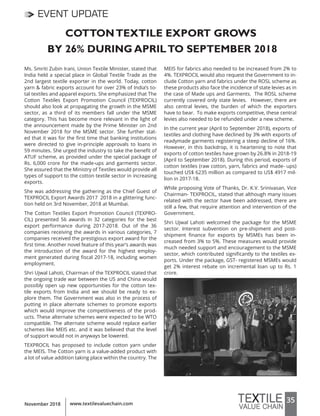
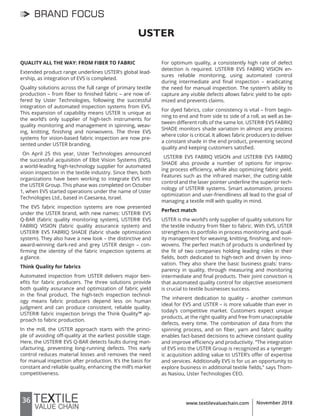




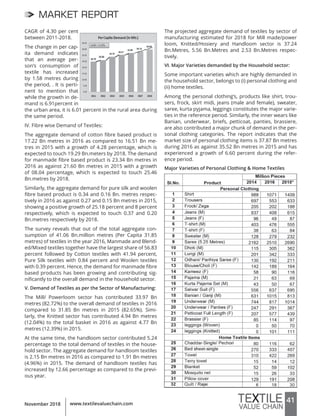
![42 www.textilevaluechain.com November 2018
On the other hand, the products like chaddar, bedsheets,
towel and terry towels contributed significantly in the
hometextile segment. In addition, the products like mos-
quito net, pillow cover or cushion cover, furnishing mate-
rials, blankets have also increased their presence in the
product basket.
Conclusion
The demand for the household sector is the major con-
tributor to the overall growth of the sector with 53.39
percentage of share in the total market size. While the
export of T&C decreased at 4.66 percentage, the demand
in household & non-household sector grew by 2.82 and
1.51 percentage respectively during 2016.
It is worth mentioning that the growth in household de-
mand of textiles has brought about additional demand
for 2525 Mn.metres of fabrics, which is an indication to
the required capacity expansion in the fabrics manufac-
turing in the country. Similarly, the growing demand for
the newly emerged products like legging etc. provides
an indication at the change in preference pattern of the
consumers in the country during the period. Hence, the
many findings in the report may provide authentic data &
insights for informed decision making by the businesses,
trade & industry, researchers & policy makers etc.
he Lenzing Group (Lenzing) has announced the launch
of a new VEOCEL™ Lyocell fiber with Eco Disperse tech-
nology which is designed for use in flushable wipes. This
new fiber demonstrates enhanced biological disintegra-
tion performance. The inclusion of this new fiber ena-
bles more diverse design opportunities while providing
exemplary wet strength and disintegration performance.
Versatile and tailor-made for daily care routines, the new
VEOCEL™ Lyocell fiber with Lenzing’s Eco Disperse tech-
nology offers optimized flushability and represents the
most advanced fiber under the VEOCEL™ brand portfolio.
With botanic origin, all VEOCEL™ Lyocell fibers with Eco
Disperse technology feature strong wet strength, biodeg-
radability and effective liquid management. These cellu-
losic fibers come in cut lengths of 8 mm to
12 mm, and are versatile for blending ratios of 20% - 40%
in most wetlaid processing technologies. Nonwoven prod-
ucts featuring a blend containing any of the VEOCEL™
Lyocell fibers with Eco Disperse technology and wood
pulp have been certified as “fully flushable” per INDA/
EDANA[[1]] Guidelines for Assessing the Flushability of
Disposable Nonwoven Products issued in May 2018, after
passing seven rigorous industrial tests.
“Flushability” is not only a hot topic among media, regu-
lators and the nonwoven industry value chain, but also
a growing social issue that impacts the sewer infrastruc-
ture in communities around the world. The introduction
of VEOCEL™ Lyocell fibers with Eco Disperse technology is
a positive example of Lenzing’s advocacy for the adoption
of more sustainable alternatives in the nonwoven indus-
try value chain and meets the various product and perfor-
mance requirements across different core markets.
“We take a proactive approach and lay the foundation for
flushable wet wipes that combine convenience with en-
vironmental responsibility, so that we can bring optimal
quality and performance to flushable nonwoven prod-
ucts, as well as other nonwoven segments,” said Wolf-
gang Plasser, Vice President of Global Business Manage-
ment Nonwovens, Lenzing AG.
While non-biodegradable synthetic fibers (e.g. polyester)
are the most common blending fibers in today’s nonwo-
ven fabrics for wipes applications, the versatility of VEO-
CEL™ fibers offer a sustainable and botanic alternative to
synthetic materials. When added to nonwoven products,
VEOCEL™ Lyocell fibers offers value-added benefits of en-
hanced absorbency, natural smoothness, and most im-
portantly, biodegradability.
Enabled by Eco Disperse technology, wipes made from
the new VEOCEL™ Lyocell fibers have high wet strength
usability and can disintegrate within a shorter period of
time. For instance, nonwoven fabrics with 20% of the new
VEOCEL™ Lyocell fibers and 80% of wood pulp reach >90%
disintegration within 30 minutes, which is faster than the
passing benchmark of the Disintegration Test FG502 in
INDA/EDANA Guidelines for Assessing the Flushability of
Disposable Nonwoven Products issued in May 2018.
VEOCEL™ Lyocell fibers are produced via a sustainable,
closed-loop process, where >99% of the solvent used for
the production process will be recovered and reused. The
fibers can be adopted as blending material for nonwo-
ven products including baby wipes, facial cleansing wipes,
flushable wipes, general purpose wipes, and intimate
wipes.
LENZING INTRODUCES NEWVEOCEL™ LYOCELL FIBERS DESIGNED
FOR ECO-RESPONSIBLE FLUSHABLE WIPES
MARKET REPORT
NEWS](https://image.slidesharecdn.com/novemberissue2018finalpdf-181127060637/85/TEXTILE-VALUE-CHAIN-November-issue-2018-42-320.jpg)
